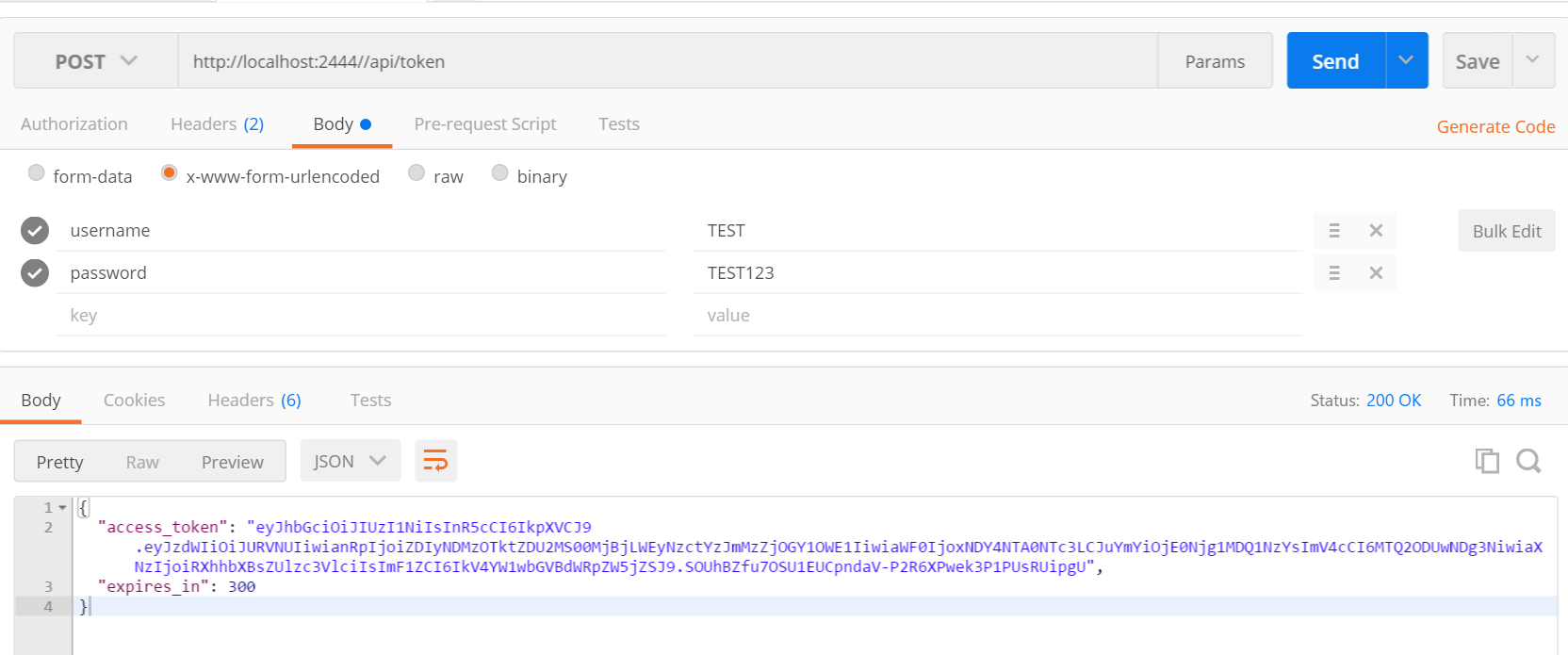令牌认证(Token Authentication)已经成为单页应用(SPA)和移动应用事实上的标准。即使是传统的B/S应用也能利用其优点。优点很明白:极少的服务端数据管理、可扩展性、可以使用单独的认证服务器和应用服务器分离。
如果你对令牌(token)不是太了解,可以看这篇文章( overview of token authentication and JWTs)
令牌认证在asp.net core中集成。其中包括保护Bearer Jwt的路由功能,但是移除了生成token和验证token的部分,这些可以自定义或者使用第三方库来实现,得益于此,MVC和Web api项目可以使用令牌认证,而且很简单。下面将一步一步实现,代码可以在( 源码)下载。
ASP.NET Core令牌验证首先,背景知识:认证令牌,例如JWTs,是通过http 认证头传递的,例如:
GET /fooAuthorization: Bearer [token]
令牌可以通过浏览器cookies。传递方式是header或者cookies取决于应用和实际情况,对于移动app,使用headers,对于web,推荐在html5 storage中使用cookies,来防止xss攻击。
asp.net core对jwts令牌的验证很简单,特别是你通过header传递。
1、生成 SecurityKey,这个例子,我生成对称密钥验证jwts通过HMAC-SHA256加密方式,在startup.cs中:
// secretKey contains a secret passphrase only your server knowsvar secretKey = "mysupersecret_secretkey!123";var signingKey = new SymmetricSecurityKey(Encoding.ASCII.GetBytes(secretKey));
验证 header中传递的JWTs在 Startup.cs中,使用Microsoft.AspNetCore.Authentication.JwtBearer中的UseJwtBearerAuthentication 方法获取受保护的api或者mvc路由有效的jwt。
var tokenValidationParameters = new TokenValidationParameters{// The signing key must match!ValidateIssuerSigningKey = true,IssuerSigningKey = signingKey,// Validate the JWT Issuer (iss) claimValidateIssuer = true,ValidIssuer = "ExampleIssuer",// Validate the JWT Audience (aud) claimValidateAudience = true,ValidAudience = "ExampleAudience",// Validate the token expiryValidateLifetime = true,// If you want to allow a certain amount of clock drift, set that here:ClockSkew = TimeSpan.Zero};app.UseJwtBearerAuthentication(new JwtBearerOptions{AutomaticAuthenticate = true,AutomaticChallenge = true,TokenValidationParameters = tokenValidationParameters});通过这个中间件,任何[Authorize]的请求都需要有效的jwt:
签名有效;
过期时间;
有效时间;
Issuer 声明等于“ExampleIssuer”
订阅者声明等于 “ExampleAudience”
如果不是合法的JWT,请求终止,issuer声明和订阅者声明不是必须的,它们用来标识应用和客户端。
在cookies中验证JWTsASP.NET Core中的cookies 认证不支持传递jwt。需要自定义实现 ISecureDataFormat接口的类。现在,你只是验证token,不是生成它们,只需要实现Unprotect方法,其他的交给System.IdentityModel.Tokens.Jwt.JwtSecurityTokenHandler这个类处理。
using System;using System.IdentityModel.Tokens.Jwt;using System.Security.Claims;using Microsoft.AspNetCore.Authentication;using Microsoft.AspNetCore.Http.Authentication;using Microsoft.IdentityModel.Tokens; namespace SimpleTokenProvider{public class CustomJwtDataFormat : ISecureDataFormat<AuthenticationTicket>{private readonly string algorithm;private readonly TokenValidationParameters validationParameters; public CustomJwtDataFormat(string algorithm, TokenValidationParameters validationParameters){this.algorithm = algorithm;this.validationParameters = validationParameters;} public AuthenticationTicket Unprotect(string protectedText)=> Unprotect(protectedText, null); public AuthenticationTicket Unprotect(string protectedText, string purpose){var handler = new JwtSecurityTokenHandler();ClaimsPrincipal principal = null;SecurityToken validToken = null; try{principal = handler.ValidateToken(protectedText, this.validationParameters, out validToken); var validJwt = validToken as JwtSecurityToken; if (validJwt == null){throw new ArgumentException("Invalid JWT");} if (!validJwt.Header.Alg.Equals(algorithm, StringComparison.Ordinal)){throw new ArgumentException($"Algorithm must be "{algorithm}"");} // Additional custom validation of JWT claims here (if any)}catch (SecurityTokenValidationException){return null;}catch (ArgumentException){return null;} // Validation passed. Return a valid AuthenticationTicket:return new AuthenticationTicket(principal, new AuthenticationProperties(), "Cookie");} // This ISecureDataFormat implementation is decode-onlypublic string Protect(AuthenticationTicket data){throw new NotImplementedException();} public string Protect(AuthenticationTicket data, string purpose){throw new NotImplementedException();}}}在startup.cs中调用
var tokenValidationParameters = new TokenValidationParameters{// The signing key must match!ValidateIssuerSigningKey = true,IssuerSigningKey = signingKey, // Validate the JWT Issuer (iss) claimValidateIssuer = true,ValidIssuer = "ExampleIssuer", // Validate the JWT Audience (aud) claimValidateAudience = true,ValidAudience = "ExampleAudience", // Validate the token expiryValidateLifetime = true, // If you want to allow a certain amount of clock drift, set that here:ClockSkew = TimeSpan.Zero}; app.UseCookieAuthentication(new CookieAuthenticationOptions{AutomaticAuthenticate = true,AutomaticChallenge = true,AuthenticationScheme = "Cookie",CookieName = "access_token",TicketDataFormat = new CustomJwtDataFormat(SecurityAlgorithms.HmacSha256,tokenValidationParameters)});如果请求中包含名为access_token的cookie验证为合法的JWT,这个请求就能返回正确的结果,如果需要,你可以加上额外的jwt chaims,或者复制jwt chaims到ClaimsPrincipal在CustomJwtDataFormat.Unprotect方法中,上面是验证token,下面将在asp.net core中生成token。
ASP.NET Core生成Tokens 在asp.net 4.5中,这个UseOAuthAuthorizationServer中间件可以轻松的生成tokens,但是在asp.net core取消了,下面写一个简单的token生成中间件,最后,有几个现成解决方案的链接,供你选择。
简单的token生成节点
首先,生成 POCO保存中间件的选项. 生成类:TokenProviderOptions.cs
using System;using Microsoft.IdentityModel.Tokens; namespace SimpleTokenProvider{public class TokenProviderOptions{public string Path { get; set; } = "/token"; public string Issuer { get; set; } public string Audience { get; set; } public TimeSpan Expiration { get; set; } = TimeSpan.FromMinutes(5); public SigningCredentials SigningCredentials { get; set; }}}现在自己添加一个中间件,asp.net core 的中间件类一般是这样的:
using System.IdentityModel.Tokens.Jwt;using System.Security.Claims;using System.Threading.Tasks;using Microsoft.AspNetCore.Http;using Microsoft.Extensions.Options;using Newtonsoft.Json;namespace SimpleTokenProvider{public class TokenProviderMiddleware{private readonly RequestDelegate _next;private readonly TokenProviderOptions _options;public TokenProviderMiddleware(RequestDelegate next,IOptions<TokenProviderOptions> options){_next = next;_options = options.Value;}public Task Invoke(HttpContext context){// If the request path doesn"t match, skipif (!context.Request.Path.Equals(_options.Path, StringComparison.Ordinal)){return _next(context);}// Request must be POST with Content-Type: application/x-www-form-urlencodedif (!context.Request.Method.Equals("POST")|| !context.Request.HasFormContentType){context.Response.StatusCode = 400;return context.Response.WriteAsync("Bad request.");}return GenerateToken(context);}}}这个中间件类接受TokenProviderOptions作为参数,当有请求且请求路径是设置的路径(token或者api/token),Invoke方法执行,token节点只对 POST请求而且包括form-urlencoded内容类型(Content-Type: application/x-www-form-urlencoded),因此调用之前需要检查下内容类型。
最重要的是GenerateToken,这个方法需要验证用户的身份,生成jwt,传回jwt:
private async Task GenerateToken(HttpContext context){var username = context.Request.Form["username"];var password = context.Request.Form["password"]; var identity = await GetIdentity(username, password);if (identity == null){context.Response.StatusCode = 400;await context.Response.WriteAsync("Invalid username or password.");return;} var now = DateTime.UtcNow; // Specifically add the jti (random nonce), iat (issued timestamp), and sub (subject/user) claims.// You can add other claims here, if you want:var claims = new Claim[]{new Claim(JwtRegisteredClaimNames.Sub, username),new Claim(JwtRegisteredClaimNames.Jti, Guid.NewGuid().ToString()),new Claim(JwtRegisteredClaimNames.Iat, ToUnixEpochDate(now).ToString(), ClaimValueTypes.Integer64)}; // Create the JWT and write it to a stringvar jwt = new JwtSecurityToken(issuer: _options.Issuer,audience: _options.Audience,claims: claims,notBefore: now,expires: now.Add(_options.Expiration),signingCredentials: _options.SigningCredentials);var encodedJwt = new JwtSecurityTokenHandler().WriteToken(jwt); var response = new{access_token = encodedJwt,expires_in = (int)_options.Expiration.TotalSeconds}; // Serialize and return the responsecontext.Response.ContentType = "application/json";await context.Response.WriteAsync(JsonConvert.SerializeObject(response, new JsonSerializerSettings { Formatting = Formatting.Indented }));}大部分代码都很官方,JwtSecurityToken 类生成jwt,JwtSecurityTokenHandler将jwt编码,你可以在claims中添加任何chaims。验证用户身份只是简单的验证,实际情况肯定不是这样的,你可以集成 identity framework或者其他的,对于这个实例只是简单的硬编码:
private Task<ClaimsIdentity> GetIdentity(string username, string password){// DON"T do this in production, obviously!if (username == "TEST" && password == "TEST123"){return Task.FromResult(new ClaimsIdentity(new System.Security.Principal.GenericIdentity(username, "Token"), new Claim[] { }));} // Credentials are invalid, or account doesn"t existreturn Task.FromResult<ClaimsIdentity>(null);}添加一个将DateTime生成timestamp的方法:
public static long ToUnixEpochDate(DateTime date)=> (long)Math.Round((date.ToUniversalTime() - new DateTimeOffset(1970, 1, 1, 0, 0, 0, TimeSpan.Zero)).TotalSeconds);
现在,你可以将这个中间件添加到startup.cs中了:
using System.Text;using Microsoft.AspNetCore.Builder;using Microsoft.AspNetCore.Hosting;using Microsoft.Extensions.Configuration;using Microsoft.Extensions.DependencyInjection;using Microsoft.Extensions.Logging;using Microsoft.Extensions.Options;using Microsoft.IdentityModel.Tokens; namespace SimpleTokenProvider{public partial class Startup{public Startup(IHostingEnvironment env){var builder = new ConfigurationBuilder().AddJsonFile("appsettings.json", optional: true);Configuration = builder.Build();} public IConfigurationRoot Configuration { get; set; } public void ConfigureServices(IServiceCollection services){services.AddMvc();} // The secret key every token will be signed with.// In production, you should store this securely in environment variables// or a key management tool. Don"t hardcode this into your application!private static readonly string secretKey = "mysupersecret_secretkey!123"; public void Configure(IApplicationBuilder app, IHostingEnvironment env, ILoggerFactory loggerFactory){loggerFactory.AddConsole(LogLevel.Debug);loggerFactory.AddDebug(); app.UseStaticFiles(); // Add JWT generation endpoint:var signingKey = new SymmetricSecurityKey(Encoding.ASCII.GetBytes(secretKey));var options = new TokenProviderOptions{Audience = "ExampleAudience",Issuer = "ExampleIssuer",SigningCredentials = new SigningCredentials(signingKey, SecurityAlgorithms.HmacSha256),}; app.UseMiddleware<TokenProviderMiddleware>(Options.Create(options)); app.UseMvc();}}}测试一下,推荐使用chrome 的postman:
POST /tokenContent-Type: application/x-www-form-urlencodedusername=TEST&password=TEST123
结果:
OK
Content-Type: application/json
{
"access_token": "eyJhb...",
"expires_in": 300
}
你可以使用jwt工具查看生成的jwt内容。如果开发的是移动应用或者单页应用,你可以在后续请求的header中存储jwt,如果你需要在cookies中存储的话,你需要对代码修改一下,需要将返回的jwt字符串添加到cookie中。
测试下:


其他方案
下面是比较成熟的项目,可以在实际项目中使用:
- AspNet.Security.OpenIdConnect.Server – ASP.NET 4.x的验证中间件。
- OpenIddict – 在identity上添加OpenId验证。
- IdentityServer4 – .NET Core认证中间件(现在测试版本)。
下面的文章可以让你更加的了解认证:
- Overview of Token Authentication Features
- How Token Authentication Works in Stormpath
- Use JWTs the Right Way!
以上就是本文的全部内容,希望对大家的学习有所帮助,也希望大家多多支持脚本之家。

